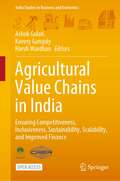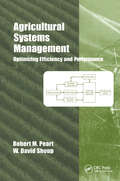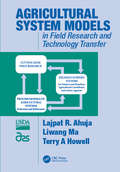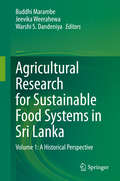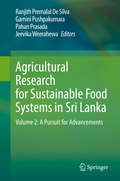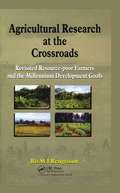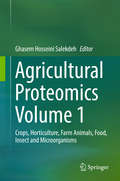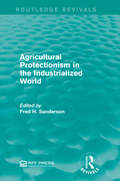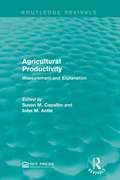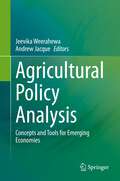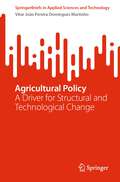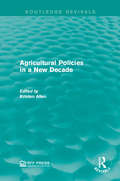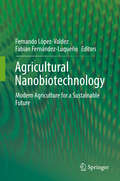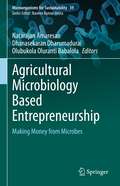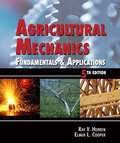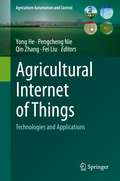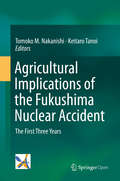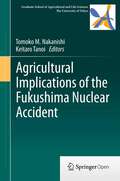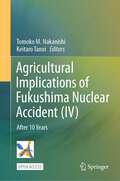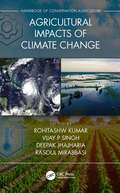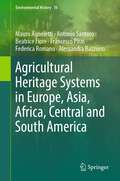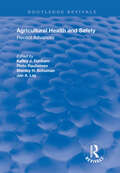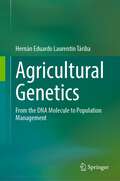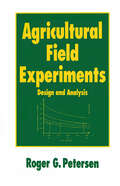- Table View
- List View
Agricultural Value Chains in India: Ensuring Competitiveness, Inclusiveness, Sustainability, Scalability, and Improved Finance (India Studies in Business and Economics)
by Harsh Wardhan Ashok Gulati Kavery GangulyThis open access book provides a clear holistic conceptual framework of CISS-F (competitiveness, inclusiveness, sustainability, scalability and access to finance) to analyse the efficiency of value chains of high value agricultural commodities in India. It is based on the understanding that agriculture is an integrated system that connects farming with logistics, processing and marketing. Farmer’s welfare being central to any agricultural policy makes it very pertinent to study how a value chain works and can be strengthened further to realize this policy goal. This book adds value to the existing research by studying the value chains end-to-end across a wide spectrum of agricultural commodities with the holistic lens of CISS-F. It is not enough that a value chain is competitive but not inclusive or it is competitive and inclusive but not sustainable. The issue of scalability is very critical to achieve macro gains in terms of greater farmer outreach and sectoral growth. The research undertaken here brings out some very useful insights for policymaking in terms of what needs to be done better to steer the agricultural value chains towards being more competitive, inclusive, sustainable and scalable. The value chain specific research findings help draw very nuanced policy recommendations as well as present a big picture of the future direction of policy making in agriculture.
Agricultural Systems Management: Optimizing Efficiency and Performance
by Robert M. Peart; W. David ShoupRunning a productive agriculture system has always been about having the right tools and the know-how to pursue optimization and efficiency. In the 21st century, the case can be made that the agriculturist's most important tool is not the cultivator, but the computer. While you still need to know how to adapt to the day-to-day challenges of land an
Agricultural System Models in Field Research and Technology Transfer
by Liwang Ma Lajpat R. Ahuja Terry A. HowellMost books covering the use of computer models in agricultural management systems target only one or two types of models. There are few texts available that cover the subject of systems modeling comprehensively and that deal with various approaches, applications, evaluations, and uses for technology transfer. Agricultural System Models in Field Res
Agricultural Research for Sustainable Food Systems in Sri Lanka: Volume 1: A Historical Perspective
by Buddhi Marambe Jeevika Weerahewa Warshi S. DandeniyaA food system comprises the entire range of actors and interlinked activities related to food production, processing, distribution, marketing and trade, preparation, consumption, and disposal. When a food system operates without compromising the needs of future generations, it is considered to be a “Sustainable Food System.” The present-day food systems in Sri Lanka are diverse, and the natural and physical environment, infrastructure, institutions, society and culture, and policies and regulations within which the food systems operate, as well as the technologies employed, have shaped their outcomes. Agricultural research is a key factor in terms of innovation and technological advances. Innovation has been the main driver of food systems’ transformation over the past few decades and will be critical to addressing the needs of a rapidly growing population in a context of climate change and scarcity of natural resources. In addition, agricultural research must help meet the rising demand for food at affordable prices. Comprising 17 chapters written by specialist(s) in their respective subject-areas, this Contributed Volume on “Agricultural Research for Sustainable Food Systems in Sri Lanka: A Historical Perspective” shares the scientific knowledge accumulated by the National Agricultural Research System of Sri Lanka, including universities, and offers recommendations on how to make food systems more sustainable in order to address the current needs of Sri Lankan society. It presents perspectives on four key thematic areas, namely: (i) Crop and animal production, management, and improvement, (ii) Agro-product processing technologies, (iii) Natural resource management, and (iv) Socio-economic development and agri-business management.
Agricultural Research for Sustainable Food Systems in Sri Lanka: Volume 2: A Pursuit for Advancements
by Ranjith Premalal De Silva Gamini Pushpakumara Pahan Prasada Jeevika WeerahewaFood systems involve a range of activities concerning food production, processing, distribution, marketing and trade, preparation, consumption and disposal. They encompass the path of food from the farm to the dinner table, meeting the food and nutritional needs of a nation. When such systems do so without sacrificing the needs of future generations, they are referred to as “Sustainable Food Systems.” The natural and physical environment, infrastructure, institutions, society and culture, and policies and regulations within which they operate, as well as the technologies they adopt, shape these systems’ outcomes. Making food systems more sustainable is a key priority for all nations, and Sri Lanka is no exception. Food systems deliver optimal performance when the policy and regulatory environment is conducive, institutions are supportive, and a combination of agricultural research investments and an efficient extension system generates the technologies and scientific evidence required for sound policymaking and agenda setting. Further, agricultural research can generate essential findings, technologies and policies for sustainable agricultural development – across disciplines, sectors and stakeholder groups. This book shares valuable insights into research conducted in the broad food and agriculture sectors in Sri Lanka. It also discusses the status quo in related disciplines, and outlines future research directions. Accordingly, it offers a valuable source of reference material for researchers, students, and stakeholders in the food and agriculture sectors, while also highlighting the types of support that policymakers and other decision-makers can provide.
Agricultural Research at the Crossroads: Revisited Resource-poor Farmers and the Millennium Development Goals
by Bo M. I. BengtssonIt is necessary to integrate field data relevant to policy with a global overview with up-to-date information for synthesis into scenarios and a vision of how future research and development in agriculture can best help those who are most needy and have little access to productive resources. The overall task is a huge challenge for policy-makers and the agricultural research establishment. It is also of concern in teaching agricultural students to be able to respond to future challenges. This publication is an attempt to stimulate discussion on future options of research policy, suggesting changes of agricultural R&D for societal development in accordance with the Millennium Development Goals.
Agricultural Proteomics Volume 2: Crops, Horticulture, Farm Animals, Food, Insect and Microorganisms
by Ghasem Hosseini SalekdehThis book will cover several topics to elaborate how proteomics may contribute in our understanding of mechanisms involved in stress adaptation. The knowledge being accumulated by a wide range of proteomics technologies may eventually be utilized in breeding programs to enhance stress tolerance. This book presents comprehensive reviews about responses of crop and farm animals to environmental stresses. Challenges related to stress phenotyping and integration of proteomics and other omics data have also been addressed.
Agricultural Protectionism in the Industrialized World (Routledge Revivals)
by Fred H. SandersonOriginally published in 1990, Agricultural Protectionism in the Industrialized World takes a detailed look into the domestic and international agricultural policies of the United States, Europe, Canada, Japan, Australia and New Zealand. These areas are some of the most industrialised in the world and this study focuses on the benefits, policies and costs related to protectionism of their agriculture. These papers offer detailed analysis of the evolution, objections and domestic and international implications related to agriculture in specific countries as well as taking a global view of issues such as policy, trends and costs and concluding with a discussion on the effects of free trade. This title will be of interest to students of environmental studies.
Agricultural Productivity: Measurement and Explanation (Routledge Revivals)
by Susan M. Capalbo John M. AntleThis book, first published in 1988, provides a comprehensive, integrated body of knowledge concerning agricultural productivity research, highlighting both its strengths and limitations. This book will be of value to scholars and research leaders for the knowledge it conveys of future productivity research, and will also be of interest to students of environmental studies.
Agricultural Policy Analysis: Concepts and Tools for Emerging Economies
by Jeevika Weerahewa Andrew JacqueThis book is centred around various interwoven topics which are fundamental to policy analysis in agriculture. Key concepts and tools that are fundamental for the analysis of agricultural policies and programmes are presented. Key concepts introduced include, the role of the state in a market economy with examples from the Sri Lankan and other developing economies, the international trade environment, and conceptual frameworks for analysing important domestic and international trade policies. It also highlights interconnections among agriculture, development, policy and illustrates the extent to which the agricultural sector contributes in achieving economic growth objectives, equity and equality objectives and environmental objectives. The book takes the readers through the nature of agricultural markets in developing countries, with special emphasis on Sri Lanka, and illustrates how the degree of competitiveness is measured at various market levels using multiple indices and methods. Several tools, with accompanying case studies, for the analysis of policies and programmes are detailed. These tools include the GTAP model, gravity models, extended benefit cost analysis, and linear programming. Tools and models are applied to the analysis of trade policies and agreements, marketing policies, environmental services, extension programmes, land tenure reforms and climate change adaptations. Case studies in relation to the agri-food policy and strategy response to COVID-19 Pandemic are also covered. This book is of interest to public officials working in agricultural planning and agricultural policy, teachers, researchers, agro-economists, capacity builders and policymakers. Also the book serves as additional reading material for undergraduate and graduate students of agriculture, development studies, and environmental sciences. National and international agricultural scientists, policy makers will also find this to be a useful read.
Agricultural Policy: A Driver for Structural and Technological Change (SpringerBriefs in Applied Sciences and Technology)
by Vítor João MartinhoThis book gives insights into the agricultural policies in several countries located in different continents. It is of interest to students, researchers, and policy and decision makers.Given the particularities of agriculture, agricultural policies are indispensable for an adjusted development of farms according to the strategic objectives of each country, namely the socio-economic and environmental ones. The question that often arises is whether the practical effects of the various policy measures are in accordance with their design and what is the effect of these policy instruments among many other causes of structural and technological change. The aim of this book is to describe the main agricultural policies that have been implemented in countries such as the United States of America, Brazil, China, India, South Africa, Australia, as well as the European Union. It also aims to analyse the real impact of these policies on the structural and technological changes of farms in the European Union. As its methodology, the book considers bibliometric analysis, literature review and statistical approaches.
Agricultural Policy: Farm Programs and National Welfare
by Rainer SchickeleThis book is written for the student of rural America, be he farmer, businessman, labor leader, public servant, college student, or instructor, anyone who is curious to understand what problems farmers are facing in their relations to an industrial world, and what the government is doing to help them meet these problems.
Agricultural Policies in a New Decade (Routledge Revivals)
by Kristen AllenAgricultural Policies in a New Decade was written in preparation for the 1990 Farm Bill in the United States in collaboration with the Food and Agriculture Committee of the National Planning Association. Originally published in the same year, this study aims to inform on the key issues affecting the new bill including budget austerity, the effects of agriculture on environmental quality, the safety and security of the U.S. food supply and international markets and trade policy. This title will be of interest to students of Environmental Studies and policy makers.
Agricultural Nanobiotechnology: Modern Agriculture for a Sustainable Future
by Fernando López-Valdez Fabián Fernández-LuqueñoNanobiotechnology in agriculture is a new knowledge area that offers novel possibilities to achieve high productivity levels at manageable costs during the production and merchandising of crops. This book shows us how we can use the cutting-edge knowledge about agriculture, nanotechnology, and biotechnology to increase the agricultural productivity and shape a sustainable future in order to increase the social welfare in rural areas and preserve the environmental health. Specialists from several countries will provide their feedback on a range of relevant topics such as environment-friendly use of nanofertilisers, nanodevices, nano-food packaging, nanocoating and nanocarriers and their relationship with the modern agriculture.
Agricultural Microbiology Based Entrepreneurship: Making Money from Microbes (Microorganisms for Sustainability #39)
by Natarajan Amaresan Dhanasekaran Dharumadurai Olubukola Oluranti BabalolaThis book is first part of the 3 volume set focusing on basic and advanced methods for using microbiology as an entrepreneurial venture. This volume explains the entrepreneurship skills for production, cost-benefit analysis and marketing of bio-fertilizers, bio-pesticides, bio-insecticides, seaweed liquid biofertilizer, and phosphate solubilizers. Chapters cover the applications of microorganisms in small and large scale production to achieve a sustainable output. The book provides essential knowledge and working business protocols from all related disciplines in agribusiness, organic farming, and economic integration. This book is useful to graduate students, research scholars and postdoctoral fellows, and teachers who belong to different disciplines via Botany, Agriculture, Environmental Microbiology and Biotechnology, Plant Pathology, and Horticulture. Next two volumes are focused on food and industrial microbiology.
Agricultural Mechanics: Fundamentals & Applications
by Ray V. HerrenA text for students learning basic mechanical skills in high school and postsecondary programs in agriscience, production agriculture, agribusiness, ornamental horticulture, and agricultural mechanics. Treatment begins with information on careers, then provides instruction on basic mechanical skills and applications. Covers use of hand tools, power tools, and stationary power equipment with numerous materials, touching on processes of wood- and metalworking, electric and gas welding, electrical wiring, robotics, plumbing, and construction. Includes color photos of male and female students, and 54 project plans. This fourth edition is revised to reflect the latest developments in the field. Annotation c. Book News, Inc., Portland, OR (booknews.com)
Agricultural Internet of Things: Technologies and Applications (Agriculture Automation and Control)
by Yong He Pengcheng Nie Qin Zhang Fei LiuInternet of things (IoT) is a new type of network that combines communication technology, expanded applications, and physical devices. Among them, agriculture is one of the most important areas in the application of the IoT technology, which has its unique requirements and integration features. Compared to the information technology in traditional agriculture, the agricultural IoT mainly refers to industrialized production and sustainable development under relatively controllable conditions. Agricultural IoT applies sensors, RFID, visual capture terminals and other types of sensing devices to detect and collect site information, and with broad applications in field planting, facility horticulture, livestock and poultry breeding, aquaculture and agricultural product logistics. It utilizes multiple information transmission channels such as wireless sensor networks, telecommunications networks and the internet to achieve reliable transmission of agricultural information at multiple scales and intelligently processes the acquired, massive information. The goals are to achieve (i) optimal control of agricultural production process, (ii) intelligent electronic trading of agricultural products circulation, and (iii) management of systematic logistics, quality and safety traceability. This book focuses on three levels of agricultural IoT network: information perception technology, information transmission technology and application technology.
Agricultural Implications of the Fukushima Nuclear Accident: The First Three Years
by Keitaro Tanoi Tomoko M. NakanishiFollowing the Fukushima nuclear accident, a large volume of monitoring data has been collected about the soil, air, dust, and seawater, along with data about an immense number of foods supplied to the market. Little is known, however, about the effect of radioactive fallout on agriculture, information about which is vital. Although more than 80% of the damaged area is related to agriculture, in situ information specifically for agriculture is scarce. This book provides data about the actual movement and accumulation of radioactivity in the ecological system--for example, whether debris deposited on mountains can be a cause of secondary contamination, under what conditions plants accumulate radioactive cesium in their edible parts, and how radioactivity is transferred from hay to milk. Because agriculture is so closely related to nature, many specialists with different areas of expertise must be involved in answering these questions. In the case of rice, researchers in rice cultivation as well as in soil, hydrology, and radioactivity measurement are working together to reveal the paths or accumulation of radioactivity in the field. For this purpose, the Graduate School of Agricultural and Life Sciences of The University of Tokyo has diverse facilities available throughout Japan, including farmlands, forests, and meadowlands. Many academic staff members have formed groups to conduct on-site research, with more than 40 volunteers participating. This book presents the data collected from the only project being systematically carried out across Japan after the Fukushima accident.
Agricultural Implications of the Fukushima Nuclear Accident: The First Three Years
by Keitaro Tanoi Tomoko M. NakanishiFollowing the Fukushima nuclear accident, a large volume of monitoring data has been collected about the soil, air, dust, and seawater, along with data about an immense number of foods supplied to the market. Little is known, however, about the effect of radioactive fallout on agriculture, information about which is vital. Although more than 80% of the damaged area is related to agriculture, in situ information specifically for agriculture is scarce. This book provides data about the actual movement and accumulation of radioactivity in the ecological system—for example, whether debris deposited on mountains can be a cause of secondary contamination, under what conditions plants accumulate radioactive cesium in their edible parts, and how radioactivity is transferred from hay to milk. Because agriculture is so closely related to nature, many specialists with different areas of expertise must be involved in answering these questions. In the case of rice, researchers in rice cultivation as well as in soil, hydrology, and radioactivity measurement are working together to reveal the paths or accumulation of radioactivity in the field. For this purpose, the Graduate School of Agricultural and Life Sciences of The University of Tokyo has diverse facilities available throughout Japan, including farmlands, forests, and meadowlands. Many academic staff members have formed groups to conduct on-site research, with more than 40 volunteers participating. This book presents the data collected from the only project being systematically carried out across Japan after the Fukushima accident.
Agricultural Implications of Fukushima Nuclear Accident (IV): After 10 Years
by Tomoko M. Nakanishi Keitaro TanoiThis open access book presents the findings from on-site research into radioactive cesium contamination in various agricultural systems affected by the Fukushima Daiichi Nuclear Power Plant accident in March 2011. This fourth volume in the series reports on studies undertaken at contaminated sites such as farmland and forests, focusing on soil, water, mountain, agricultural products, and animals. It also provides additional data collected in the subsequent years to show how the radioactivity levels in agricultural products and their growing environments have changed with time and the route by which radioactive materials entered agricultural products as well as their movement between different components (e.g., soil, water, and trees) within an environmental system (e.g., forests). The book covers various topics, including radioactivity testing of food products; decontamination trials for rice and livestock production; the state of contamination in, trees, mushrooms, and timber; the dynamics of radioactivity distribution in paddy fields and upland forests; damage incurred by the forestry and fishery industries; and the change in consumers’ attitudes. In the series of this book, a real-time radioisotope imaging system has been introduced, a pioneering technique to visualize the movement of cesium in soil and in plants. This is the only book to provide systematic data on the actual change of radioactivity, which is of great value to all researchers who wish to understand the effect of radioactive fallout on agriculture. In addition, it helps the general public better understand radio-contamination issues in the environment. The project is ongoing; the research groups from the Graduate School of Agricultural and Life Sciences of The University of Tokyo continue their work in the field further to evaluate the long-term effects of the Fukushima accident.
Agricultural Impacts of Climate Change [Volume 1]
by Rohitashw Kumar Vijay P. Singh Deepak Jhajharia Rasoul MirabbasiConservation agriculture is a sustainable production model that not only optimizes crop yields, but also reaps economic and environmental benefits as well. The adoption of successful conservation agriculture methods has resulted in energy savings, higher organic matter content and biotic activity in soil, increased crop-water availability and thus resilience to drought, improved recharge of aquifers, less erosion, and reduced impacts from the weather associated with climate change in general. Agricultural Impacts of Climate Change examines several important aspects of crop production, such as climate change, soil management, farm machinery, and different methods for sustainable conservation agriculture. It presents spatial distribution of a daily, monthly and annual precipitation concentration indices, Diffuse Reflectance Fourier Transform Infrared Spectroscopy for analyzing the organic matter in soil, and adaptation strategies for climate-related plant disease scenarios. It also discusses solar energy-based greenhouse modeling, precision farming using remote sensing and GIS, and various types of machinery used for conservation agriculture. Features: Examines the effects of climate change on agriculture and the related strategies for mitigation through practical, real-world examples Explores innovative on-farm technology options to increase system efficiency resulting in improved water usage Presents examples of precision farming using climate-resilient technologies
Agricultural Heritage Systems in Europe, Asia, Africa, Central and South America (Environmental History #16)
by Mauro Agnoletti Antonio Santoro Beatrice Fiore Francesco Piras Federica Romano Alessandra BazzurroAgriculture is often considered as one of the main threats to ecosystems. Unsustainable farming practices often result in habitat loss, inefficient use of water, soil degradation, pollution, genetic erosion, among other negative impacts on human life, including hunger, low food quality, reduced access to food resources, as well as the abandonment of rural areas. Nevertheless, when agriculture is practiced in a sustainable way, it can contribute to the preservation of many habitats, to the protection of watersheds, to the preservation and improvement of soil health.The use of sustainable and ecological practices is the key feature distinguishing traditional agriculture from intensive one. It may not provide very high yields, but ensures sustainable harvests over time, thanks to time-tested technologies and traditional know-hows and also represent examples of adaptation to harsh environmental conditions. Based on this approach, in 2002, FAO launched the concept of Globally Important Agricultural Heritage Systems (GIAHS) Programme, to identify and safeguard agricultural systems that are ensuring food and livelihood security, while maintaining magnificent landscapes, agricultural biodiversity, traditional knowledge, cultural and social values.This book presents 18 examples of these traditional agriculture systems around the world, with a special focus on Europe, Asia, Africa, Central and South America, as a result of the “GIAHS Building Capacity” project co-funded by the Italian Agency for Development Cooperation (AICS) and carried out by the Department of Agriculture, Food, Environment and Forestry (DAGRI) of the University of Florence (Italy).
Agricultural Health and Safety: Recent Advances
by Kelley J. Donham Risto Rautiainen Stanley H Schuman Jan LayProtect yourself from machinery accidents, skin cancer, pesticide exposure, and so much more!Maintaining safety on the farm is a greater challenge than ever. Farmers are trying to expand their farm size and increase production while coping with labor shortages, adverse weather, and equipment problems. Agricultural Health and Safety gives you an in-depth look at these issues and presents effective new approaches to intervention and education for farm health and safety problems. Agricultural Health and Safety discusses new research, education, and prevention programs that have been tested from Maine to California and from Australia to Sweden. These important scientific and analytical studies were presented at the 1996 National Institute for Occupational Safety and Health Conference in Iowa. In addition to suggesting new ways to deal with the recognized physical hazards of farming, Agricultural Health and Safety discusses the often neglected role of mental health. It examines the role of stress in causing accidents and the risks of depression and suicide among agricultural workers. Agricultural Health and Safety considers a broad range of problems and effective interventions, including: insurance incentives for safe farms accident-prevention programs training for responding to farm emergencies cutting the risks of accident for farm children the ergonomics of milking teaching farm youth about sun safety the risks of exposure to pesticides, fertilizers, and other environmental hazardsAgricultural Health and Safety offers practical information on the broad spectrum of health and safety hazards in the farm setting and outlines effective strategies for eliminating them. In addition, it opens new avenues for further study and research. This comprehensive book is an essential resource for agricultural safety and health researchers, program professionals, health care providers in farming communities, professors and students in agromedicine and agricultural programs, and agricultural workers.
Agricultural Genetics: From the DNA Molecule to Population Management
by Hernán Eduardo Laurentin TáribaReaders will find in this book a comprehensive text on the intersection of genetic and agriculture, addressing the different levels at which DNA is studied for agricultural purposes. The different subdivisions of genetics (molecular, Mendelian, quantitative and populations) are all discussed in the light of agriculture research and practice. Agricultural Genetics aims to be a support for advanced and undergraduate students taking courses on biology, genetics and breeding applied to agriculture, both for plant sciences and animal sciences.
Agricultural Field Experiments: Design and Analysis (Books in Soils, Plants, and the Environment #Vol. 31)
by Roger G. PetersenThis text provides statistical and biometrical procedures for designing, conducting, analyzing and interpreting field experiments. It addresses the most important research topics in agriculture, including agronomy, breeding and pasture trials; farming systems research; and intercropping research.
